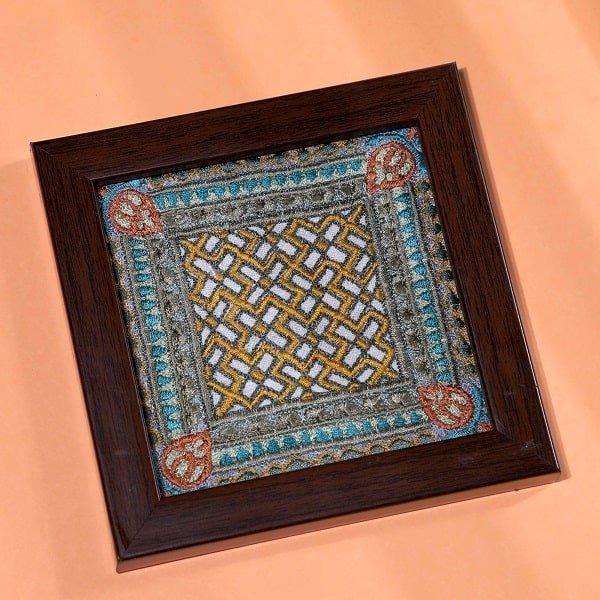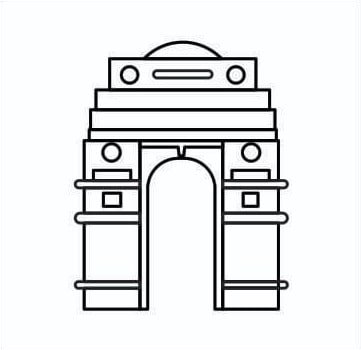Uncategorized
Showing 25–47 of 47 results
-

ODOP Lippan Kaam – The Glittering Mud Mirror Work of Kutch
₹799.00Add to cartLippan’ means ‘clay’ or ‘dung’ in local Gujarati, whereas ‘kaam’ means ‘work’. Lippan Kaam is a mud relief art form which incorporates mirrors. Traditionally used to decorate the interior and exterior walls of bhungas of Kutch, this art form has evolved over the decades.
The motifs and designs used in Lippan Kaam are inspired by everyday life. Lippan Kaam also uses repetitive geometrical motifs reflecting the tradition’s simplicity.
Contact for customisation and bulk orders.
-

Patan Patola Motif Embroidery Coaster
₹1,395.00Add to cartThe Patan Patola Motif Coaster is inspired by one of the stone-carved motifs at Rani ki Vav. This beautiful embroidery design is on off-white cotton fabric with vibrant threadwork and a 0.5″” wooden frame.
-

Patola Memento – A Textile Souvenir
Read moreDerived from the Sanskrit word ‘Pattakulla’, Patola is a double ikat weave that originated in the 11th century in the town of Patan, Gujarat, under the reign of King Kumarpal. The symmetrical designs of Patola are inspired by stone carved motifs found at the Rani-ki-Vav in Patan.
A Perfect Souvenir of India. Gift it to your loved ones and contribute to our mission of keeping this dying art alive.
-

-

Rani ki Vav Embroidery Coaster
₹1,395.00Add to cartThe Rani ki Vav Embroidery coaster is a direct translation of a carved geometrical pattern using embroidery. This beautiful embroidery design is on off-white cotton fabric with vibrant threadwork and a 0.5″ wooden frame.
-

Rani ki Vav Motif Embroidery Coaster #2
₹1,395.00Add to cartEmbroidery is the art of creating exquisite designs using needle and thread. It is a way of life, a form of non-verbal language of a culture.
Take home a timeless piece of Indian Heritage and Art and let it adorn your desks and tables. The Floral Pattern Embroidery Coaster is inspired by the stone-carved floral motifs at Rani ki Vav.
-

-

Sacred Flames – Varanasi
₹220.00Add to cartWhether you’re meditating or seeking a moment of reflection, “Sacred Flames” ignites the sacred ambiance of India’s holiest city.
-

-

-

-

-

-

-

Shanti Stupa, Ladakh – Art Print
₹199.00Add to cartLocated on a hilltop in Changspa, in the region of Leh, Shanti Stupa is the epitome of peace and tranquillity. Also known as Vishwa Shanti Stupa, it is the landmark of Leh and an important place of pilgrimage for Buddhists.
An exemplary watercolour illustration translated into this artistic souvenir. With its vibrant colours, this art print is hard to resist. Get your art print today. Available in multiple sizes and framing options. Let it adorn your desks and walls.
-

Sidi Saiyyed Ni Jali Embroidery Souvenir
Read moreThe hand embroidery of the Sidi Saiyyed ni Jali is an ode to the intricate craftsmanship of the artisans. The prestigious IIM-A has its logo inspired by the ‘tree of life’ motif.
This beautiful threadwork on off-white cotton cloth is a timeless heritage souvenir. With a 0.5″ frame, it is perfect for your work desk, side table and coffee tables. Get your hands on this keepsake memento now!
-

-

-

The Royal Bengal Tiger Art Print
₹199.00Add to cartThe magnificent Panthera Tigris, with a thick yellow coat of fur with dark stripes, the Royal Bengal Tiger is the National Animal of India. These prideful felines are solitary creatures known for their grace, strength and agility.
The Lord of the Jungle, the Royal Bengal Tiger, was honoured as the National Animal of India in April 1973. The Bengal Tiger has been a national symbol of India since the time of the Indus Valley Civilization.
The watercolour art print artistically portrays the Royal Bengal Tiger in its thick yellow fur coat with dark stripes, a perfect illustration of the Lord of the Jungle. Available in multiple sizes and framing options, you can also get your art frame in a customisable size. A perfect gift for every Indian!
-

-

Trellis Patterned Embroidery Frame
Read moreInspired by the stone carved motifs of Ahmedabad Heritage Structures, this vibrant embroidery artwork is curated in the form of a Trellis Pattern. A timeless gift of Indian Heritage, embroidery is the non-verbal language of civilization.
With our embroidery frames, appreciate the traditional art of needle and thread and add an aesthetic touch to your home! Available in multiple heritage-inspired designs.
-

Vintage Scooter Art Print
₹199.00Add to cartThe Bajaj Super is an Indian-made scooter manufactured by Bajaj Auto to produce Vespa Brand scooters in India. The design of Super was based on the Vespa Super.
Scooters come and go, but the Bajaj Super will always remain in the hearts and memories of the people.
The Super Scooter watercolour illustration is reminiscent of the good old days and will take you down memory lane. This friendship maker Bajaj Super was a gentlemen’s ride in those days!
-

Warli Painting – Memento from Gujarat
₹5,400.00Add to cartA tribal art form practised by the tribals of Sahyadri ranges, the Warli Art first originated in the state of Maharashtra. The folk art of Maharashtra, it is based on basic geometric shapes: a circle, a triangle and a square.
The enigmatic art form can be traced back to the 10th century AD. The art form is centred around mother nature and its elements, and quite often, multiple natural forms become the central focus of these artworks.










